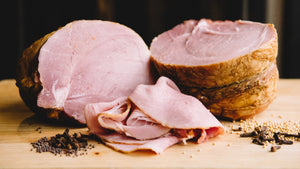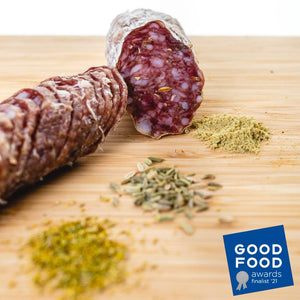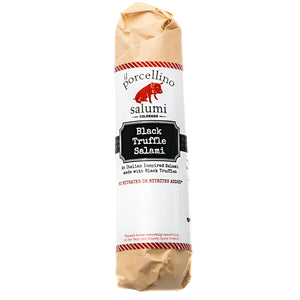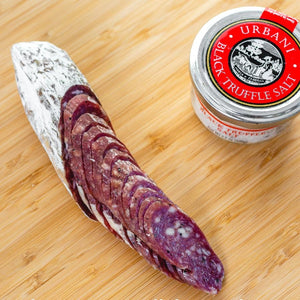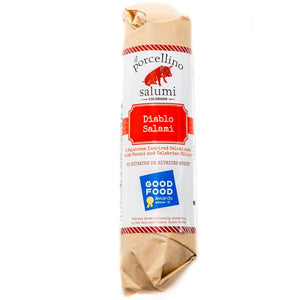Ham is a very forgiving and easy meat to cook. The large whole hams are a favorite during the holiday season, and store-bought slices make an incredible sandwich.
Believe it or not, Smoked Ham is one of the first types of cured meats that I taught myself how to make. I did some reading about how to brine and smoke them properly and formulated my recipe. This recipe is now known as il porcellino salumi Berkeley Ham and is served on our sandwiches.
As I taught myself this process, I did not have access to raw pork legs, so I used pork shoulders as I developed the recipe. The results were fattier than a traditional ham because of the part of the pig that I was using, but the flavor was unmistakable. It is now known as our signature Maple Mustard Glazed Berkeley Hams.
Because I’ve spent a good portion of my time knuckles deep in pigs, people often come to me with questions. What is ham, and where is it cut from the pig? How should I prepare and cook a whole ham?
What is ham, and what part of the pig is it?
Ham is cut from the back leg of a pig. The leg can be divided into three distinct muscles, and each one varies in size.

Hams can be either brined and smoked or dry-cured.
Brined and smoked ham is what you would think of when you buy ham at the grocery store. It can be deli-sliced for a sandwich or whole like you get for the holidays.
Dry-cured ham is typically known as prosciutto, country ham, or culatello. Cured and dried for as long as 3 - 5 years, these hams develop an unbelievable amount of flavor and sell for a fairly high price per pound. I have seen 5-year-old domestic prosciutto sold in New York City for $50/oz. That’s $800/lb!

How is ham made?
If you want to make ham from scratch, you’ll need to start with a fresh ham cut. A fresh ham is a cut from the hind leg that is not cured, smoked, or processed in any way. It’s a raw pork cut. You can get one from a butcher, but if you want it to taste like a ham you’re familiar with, you’ll need to brine and smoke it.

Our hams and nearly all the whole hams at your grocery store are brined, smoked, and pre-cooked. This is what most people are familiar with and because they’re pre or partially cooked, you’re generally reheating them at home.
To make your ham from scratch, you’ll want to start by making a brine.
You will want a specific amount of salt and some form of sodium nitrite for a ham brine. For a natural brine, you can use pure pink curing salt and celery juice powder. These ingredients give the ham its nice pink color, add flavor, and give the ham a longer shelf life.
Put all the brine ingredients into a large pot of water, and bring the brine up to a boil. Once boiling, bring the heat down and let it simmer for 15 - 20 minutes to get the most flavor out of your brine.
After 15-20 minutes, let the brine cool to room temperature, and then all the way to cold in the refrigerator.
Once the brine cools, you’ll inject it into your ham. However, if you inject a hot or warm brine, you risk the chance of “cooking” your ham at this stage. That’s why it’s essential to let the brine cool down. Please do yourself a favor and buy an excellent injector for your brine to distribute it throughout the leg muscles!
Next, we let the meat soak in the brine for ten days. That’s right, I said for ten days. This process is slow food at its finest. You can not rush a good ham, and brine soaking is an essential part of the process.
If you make ham at home, I recommend you do this, but you’ll need the refrigerator space to keep it cool.
After ten days, the ham is removed from the brine and set aside to dry off a bit. You’ll need to be able to handle the ham to tie it up and get it into the smoker! Tying a ham is a bit of a process, and you can learn the technique by watching a YouTube video. But it is a butcher’s knot, and the muscles need to be tied up really tight before smoking.
We smoke our hams with peach wood because we like the sweetness this particular wood gives to the ham. Our hams get smoked at a temperature of 225 degrees for several hours until the internal temperature reaches 150 degrees. Because the hams are smoked to 150 degrees, they are pre-cooked. Though they’re pre-cooked, you roast the ham at home to bring it up to serving temperature and to develop richer flavors.

We love the low and slow cooking method here so that we maximize the flavor. This style that we affectionately call our Berkeley Ham is known as a wet-brined and smoked ham.
If you were not to brine your pork and just smoke it, you would essentially be making a smoked pork product that resembles barbecue pork more than it does ham!
If you want to get into dry-cured hams, well, that’s going to be its own blog post. I’ll look to get something posted on the website in the New Year.
il porcellino salumi’s Maple Mustard Glazed Berkeley Hams
We make and sell whole hams for Thanksgiving and the Holidays every year at our retail store. It’s become something that not only we as a company looks forward to, but our growing customer base looks forward to as well.
Because we produce a limited amount, we sell out every year. Our deli and retail store has limited space, and because we use humanely raised Berkshire pigs and brine each ham, we can’t mass produce them. We prefer to offer less of a great product than produce something sub-par.
If you have never had one of our signature Maple Mustard Glazed Berkeley Hams, do yourself a favor and reserve one today, they’re unbelievable.

The hams come with cooking directions and a delicious Bourbon Maple Mustard Glaze to finish them off. Once hot and glazed, it’s time to thinly slice the ham and enjoy it with your family and friends.
We love making hams and hope that you get a chance to enjoy something that we, as a team, create with love.

